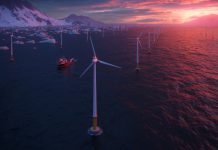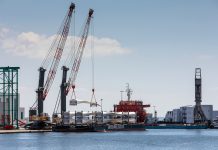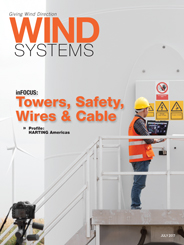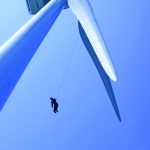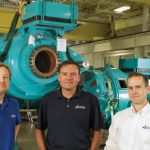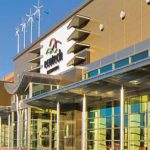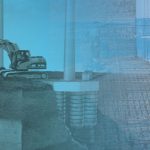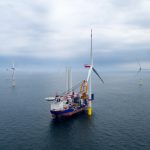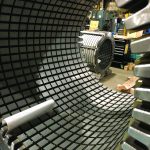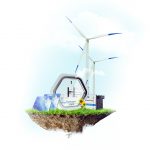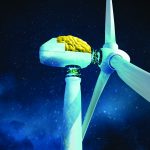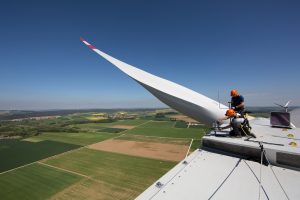The rectangular industrial connector is where it all began for HARTING Americas, but it’s grown into so much more since the company’s founder, Wilhelm Harting, started making small appliances in 1945.
HARTING’s rectangular industrial connector was meant to transfer power in industrial applications, and it revolutionized the industry, according to Will Stewart, industry segment manager for energy at HARTING.
“Since then, we’ve really expanded our portfolio,” Stewart said. “And now we have the cabling systems behind it. We have PCB connectivity; we have network components for fast or gigabit Ethernet. We have fiber-optics systems, complete RFID systems, and now we’re looking toward the future with edge devices and being able to aggregate data from legacy systems and send it to IT databases, which is what people call the Internet of Things or sending it to the cloud.”
HARTING’s products and experience are found in a plethora of industries, including wind.
“I think our goal in the wind industry is to lower the overall cost of ownership of the wind turbine,” Stewart said. “The rectangular connector is obviously a critical component.”
The Rectangular Connector

The rectangular connector is a device that passes data, signal, or power, according to Stewart, and what makes it revolutionary for industry is the benefits it can offer down the road.
“When we look at wind turbines, there are a lot of hidden costs that are involved with the ownership,” he said. “Over the 20-year lifetime of a wind turbine, operations and maintenance will cost about 54 percent of the initial cost of the turbine. Of that 54 percent, 65 percent of that is unplanned downtime. So you have a significant portion of money that is going to be given to unplanned downtime and operations and maintenance. And connectorizing can absolutely minimize that cost.”
Stewart offers the slip ring as an example.
Slip rings typically need to be replaced every three to five years. In order to replace that worn-out, hard-wired slip ring, a licensed, skilled technician has to climb up that turbine. Once there, the technician has to unplug every individual wire that’s terminated on that slip ring, remove and replace the slip ring, and terminate each individual wire again.
“It’s time consuming,” Stewart said. “It requires skilled labor. It opens the possibility to wiring errors. So there are a lot of hidden costs that are involved in hard-wiring.”
Lowering Costs
Connectorizing helps to eliminate many of those problems by eliminating some of the time-intensive repair steps.
“Now all you need to do is unplug it, take the part out, put the new part in, and plug it back in instead of having a specialized worker come in and unplug every single individual wire,” Stewart said.
Connectorizing would even help lower turbine costs during the initial construction phase, according to Stewart.
All the individual components that make up a turbine are manufactured in separate areas and brought to an assembly facility where everything is tested to make sure it works properly. It’s then disassembled and sent to the site where it’s reassembled and brought online for power generation.
“But, again, if you take for example the slip ring, you’re spending an hour, two hours, wiring that slip ring at the assembly facility, putting it in the turbine, spending the time to disassemble it again, and then shipping it out into the field and then doing all that time assembling it again,” Stewart said.
Simplifying the Supply Chain

One of HARTING Americas fastest growing lines in industrial connectivity is its Han-modular® solution, which allows multiple inserts in one hood and housing, Stewart said. This allows a customer to keep costs down by combining two individual connectors into one.
“It decreases the cost of the system,” he said. “It allows you to simplify your supply chain. It was introduced in the ’90s.”
By installing connectors in the beginning, the initial cost may be more, but it will more than pay for itself during the life of the turbine, according to Stewart.
“It’s easy to say, OK, well it’ll be an added cost to the turbine right now, but if you look at the overall ownership of a wind turbine, it can actually significantly lower your cost,” he said. “Connectorization means it takes less time to install and repair a turbine. Now, you are minimizing the cost of repair; you’re maximizing the uptime of your turbine, and you’re maximizing your ROI. Using connectors has the unique effect of both decreasing your costs and increasing your production. On top of that, it simplifies labor, and now you don’t need to find a specific technician, a specific electrician whenever there’s a problem with the electrical components of a turbine.”
And that can be an important factor as statistics show the wind-turbine technician is one of the more difficult positions to fill in the U.S. And as the industry continues to grow, the demand for those techs will only continue to increase.
“When you look at something like connectorizing, that very much assuages the problems of filling those positions,” Stewart said.
Rugged Statistics
The rectangular connector is fully IP rated and consists of a male insert, a female insert, a hood, and a housing, according to Stewart. The connector can be UV resistant, saltwater resistant for offshore turbines, EMC-resistant, and vibration proof. The insert is where the wires are terminated and physically connects the data, signal, or power.”
“That’s where you’re passing power to the motor,” he said. “Let’s say you have an anemometer that’s reading the wind speed and transmitting a 4-20mA signal; we will select the insert that allows you to pass that signal inside the cabinet. We also do data, so that’s fiber optics; that’s Ethernet communications; that can be D-sub communications. We can also pass power for the pitch or yaw motor. All of that you can fit into one connector that can be UV rated, that can be IP65, 67, all the way up to 69K. We also offer a plastic solution, which makes it a little more cost effective, a little less expensive, and lighter.”
Connector Transition
Part of HARTING’s goal is to convince American manufacturers that connectorizing is a more economical solution than a hard-wired approach, according to Stewart.
“I think the idea of connectorization, where it started, was more readily accepted in Europe,” he said. “It’s kind of where the seed took. If you go over to America, we’re more hard-wired prone, because that’s what American industry used when PLCs were being developed in the ’70s, and that momentum continues to drive engineers toward hard wiring.”
Europe has seen the benefits with connectorization, and that technology has only recently been seen as similarly beneficial in the U.S., according to Stewart.
“In America, we’re trying to show the benefits of connectorization and how it can lower your overall cost of ownership, decrease installation time, decrease maintenance time and save money in the long term for these utilities or for these companies that are purchasing the wind turbines,” he said.
Repowering Turbines
Stewart said he expects connectorization to become more of a standard in the U.S. as repowering older turbines gets more popular.
“A lot of our connectors are going on turbines that are being repowered,” he said. “I think that this is a great time to start realizing the benefits of connectorization, if you were hard wiring previously.”

A big factor in repowering turbines is the extension of the production tax credit. In order to take advantage of extending the PTC, 80 percent of a turbine’s cost must be replaced.
“You keep up to 20 percent of the old turbine, and whatever you’re putting in new has to be worth at least 80 percent of the new turbine in order to extend the PTC,” Stewart said. “That’s the rotor, and that’s the nacelle. There are a lot of electrical components that are in the hub and that are in the nacelle. And that’s really where you see a lot of the benefits of the connectorization.”
Stewart sees the repowering trend as a way to implement connectorization, especially when half the cost of a turbine often comes from unplanned maintenance.
“How do we mitigate that? This is where the connectorized solution comes in and is able to help you reduce your costs over the entire life of the turbine,” he said. “Repowering is just another opportunity for us to make our pitch about why connectorization is actually the smart solution if you want to keep your costs down.”
Major Market Segments
HARTING is involved in four major market segments: automation, machinery and robotics, transportation, and energy.
“So energy is a big focus for HARTING Americas,” Stewart said. “If you talk about our projects, we have projects all over every type of application.”
In addition to wind, some of those applications include train systems, conveyer belts, heavy machinery, data centers, switchgear, reclosers, power plants, substations, and solar inverters, according to Stewart.
 “And we have full-system solutions that we can develop,” he said. “One of our key value propositions is that we develop our products with customers. We don’t just have a line that we developed 70 years ago, and say, ‘use this; use this.’ We are always coming out with new products.”
“And we have full-system solutions that we can develop,” he said. “One of our key value propositions is that we develop our products with customers. We don’t just have a line that we developed 70 years ago, and say, ‘use this; use this.’ We are always coming out with new products.”
But specifically in wind, HARTING Americas has a hand in a lot of different systems.
“We actually can do whole-system solutions in a wind turbine, from the hub to the nacelle all the way down the tower,” Stewart said “We don’t make the actual equipment. We don’t make the gearbox. We don’t make the generator. We can do the control cabinet, but we won’t do the PLC inside of it or anything like that. But if we’re going to start from the hub, we can connectorize the pitch motor. We can connectorize the slip rings. We can get the data from the hub and through the nacelle. We can do fiber-optic or Ethernet communications through the slip ring as well. We can connectorize the anemometers and the wind vanes on top of the turbines. We can cable that all the way back to the PLC cabinets. We can do the lighting solutions all the way down the tower. We have solutions for inside the gearbox if it’s a geared turbine. We have a solution where we actually put RFID on the gears themselves, which can monitor the temperature inside the gearbox and predict failures.”
That data can be aggregated and monitored for preventive maintenance.
Cabling Solutions
In HARTING’s Elgin, Illinois, and Mexico locations, it can do the cabling involved in wind turbines as well.

“A lot of companies, a lot of OEMS, will hire a cable manufacturer and say, ‘we’ve been sold by HARTING; we know we want to use their products in order to transfer the data, signal and power, but now we have to bring in a cable house,’ and they have to get margined, and it’s just a more fragmented supply chain,” Stewart said. “We will do the cabling ourselves with cost effective solutions in Mexico, so we can do the entire connection from the cabinet to the actual machine, or from the cabinet down to the bottom of the nacelle. We have full cabling solutions. We have an engineering team on staff that’s dedicated to making these cabling solutions, and we can do all of that in house. And that’s something that not a lot of people know about, but it’s something that we’re pretty proud of, and we think that it’s a good solution for a lot of our customers.”
Customer Collaboration
A lot of the products offered by HARTING aren’t simple off-the-shelf. Stewart said HARTING prides itself in working with its customers to come up with the best solutions, and if that means creating something brand new, then that’s the path the company takes.
“I think the most important thing for us is making sure that we’re collaborating with the customer through the entire process, and making sure we’re delivering exactly what they need,” he said. “It’s not just: Send an order, and we will send it back to you. It’s: Let’s make sure we’re giving you exactly what’s best for your application at the best price point. And then if we look toward the future, we can collaborate our roadmaps so that if you will need a connectivity solution that is higher speed, is more rugged, or has integrated functionality, we are eager to work with you to make sure we can provide it.”
Stewart cites as an example a recent collaboration with customers in the U.S. and Brazil.
“One of the things that has added to the fragmented supply chain is the fact that you have to get an arrester, a surge protector, for the anemometer coming in and the wind vane coming in, and protect the components inside the cabinet in case of an electrical spike,” he said. “And we have been talking to our customers, and right now we’re developing an integrated surge protection insert, which can actually arrest any electrical spikes inside the connector.”
This innovation — which is still in development — demonstrates the benefits of connectorization with its ease of maintenance and installation, which, in turn, lowers the cost of ownership.
“By putting the arrester in the connector, you’re reducing your supply chain, and you are able to get more out of that connector,” Stewart said. “We call it smart connectivity.”
And the arrester is not only for wind, but for other industries as well, according to Stewart.
“This is an example of how we collaborate with our customers in order to give them a solution that they originally didn’t think was possible, because no one was coming up and saying, ‘hey, wouldn’t it be nice if these things were combined,’” he said. “And that’s what we like to do: Talk to our customers in order to be able to give them something that pushes the future and pushes performance.”

Continued Innovation
Although its innovative strides have remained steady, HARTING Americas has added Canada, Mexico, and Brazil to its subsidiary since it started in 1986. And the HARTING brand has a worldwide presence with more than 4,000 employees in 40 countries with 15 manufacturing plants.
And that innovation continues as HARTING Americas works on incorporating data aggregation into its already extensive portfolio.
The company has developed an edge device called MICA. The MICA can connect to a legacy system and send aggregated data to the cloud, according to Stewart. It’s Linux-based and completely open sourced. It’s rugged and IP 65/67 rated. The technology will be able to connect to every system and aggregate data in the cloud, all incorporated within a connector.
“We think the future is not just connectivity, but we think it’s going to be smart connectivity,” he said. “Intelligence inside the connector will be able to aggregate everything into one individual component, so you get the most value you can out of the fewest amount of parts. And that’s really what we’re trying to provide to our customers.”
















